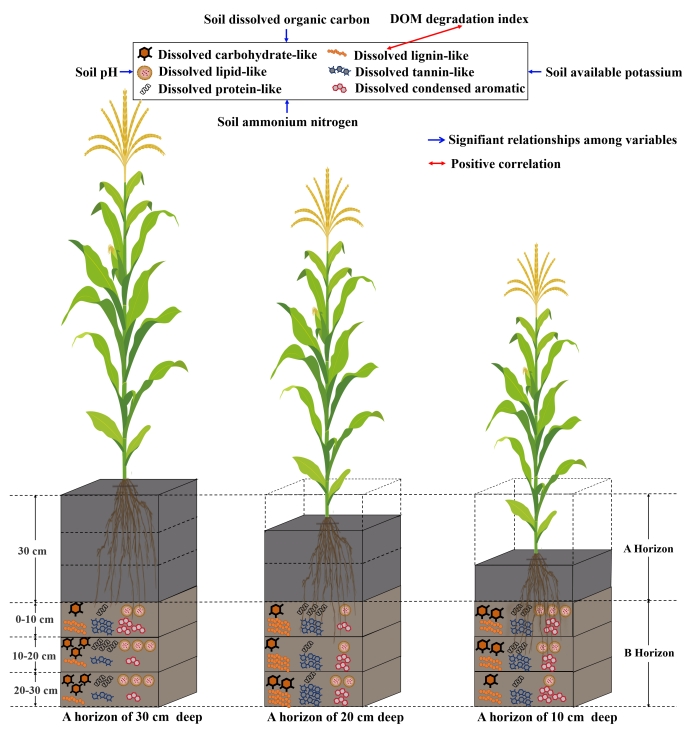Soil dissolved organic matter (DOM) chemodiversity refers to the diversity of the chemical composition and properties of DOM molecules in the soil. An exposed B horizon, owing to soil erosion, significantly affects its DOM dynamics. Exploring the variation of soil DOM chemodiversity on the B horizon and describing the specific factors that influence DOM chemodiversity in eroded soils is essential to predict the reactivity and dynamics of DOM and SOM under these changing conditions.
Recently, a research team led by Prof. LIU Xiaobing from the Key Laboratory of Black Soils Conservation and Utilization, Northeast Institute of Geography and Agroecology, Chinese Academy of Science (CAS) revealed that DOM chemodiversity in the B horizon showed varying responses to A horizon erosion.
This work was published in Soil Biology and Biochemistry on Nov. 17.
This study is based on a long-term in-situ simulated erosion experiment established at the Hailun Mollisol Erosion Monitoring and Research Station, which included three treatments: an A horizon of 30 cm (non-eroded), 20 cm (mild erosion), and 10 cm (severe erosion) deep for research purposes. Fourier transform ion cyclotron resonance mass spectrometry (FT-ICR-MS) was used to determine the relative abundance of seven compounds (lipid-like, protein-like, carbohydrate-like, unsaturated hydrocarbon-like, lignin-like, tannin-like and condensed aromatic compounds), the relative proportion of CHONS type compounds and the DOM degradation degree.
The results showed that compared to non-eroded, the severe erosion treatment significantly increased the dissolved lignin-like compounds by 24-63% across the 0-30 cm layers of the B horizon; the mild erosion significantly enhanced dissolved lignin-like compounds by 41% and 22% in the 10-20 and 20-30 cm layers of the B horizon respectively. Relative to non-eroded treatment, the mild and severe erosion treatments both reduced the lipid- and protein-like compounds by 69–87% in 10–20 and 20–30 cm layers of the B horizon layers. Soil properties including pH and available nutrients, not microbial traits, were primarily responsible for DOM variations.
Further, DOM degradation index was positively correlated with dissolved lignin-like compounds, implying that lignin, a recalcitrant compound, was degraded. Thus, eroded Mollisols had less carbon sequestration potential in the B horizon. To prevent soil deterioration in corn-soybean rotations, we recommend to incorporate a combination of organic and mineral fertiliser to a 20-30 cm soil depth in erosion-susceptible Mollisols.
The findings may enhance understanding regarding the persistence and diversity of DOM molecules within soils, thereby facilitating the prediction of the carbon cycle in eroded Mollisols.

Figure 1. Kernel density plots of chemical formulas of DOM components based on van Krevelen diagrams. Darker colours are indicative of a higher molecular density.
(Image by ZHOU Meng)

Figure 2. Variations and influencing factors of dissolved organic matter chemodiversity in the different layers of the B horizon under simulated erosion of A horizon.
(Image by ZHOU Meng)
Contact:
Yansheng Li
Northeast Institute of Geography and Agroecology, Chinese Academy of Sciences
E-mail: liyansheng@iga.ac.cn
Reference:
Zhou M, Xiao Y, Li YS*, Liu J, Sui YY, Zhang XY, Liu XB. Simulated erosion of A horizon influences the dissolved organic matter chemodiversity and carbon sequestration of B horizon in Mollisols. Soil Biology and Biochemistry, 2024. doi: 10.1016/j.soilbio.2024.109648.
https://doi.org/10.1016/j.soilbio.2024.109648.
Key words: Reducing topsoil thickness, Lignin Degradation degree, Chemical composition, FT-ICR-MS